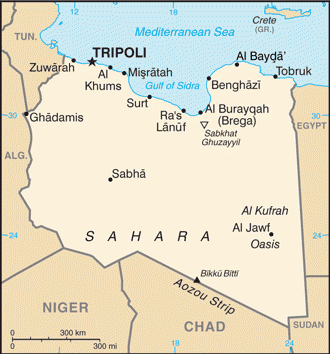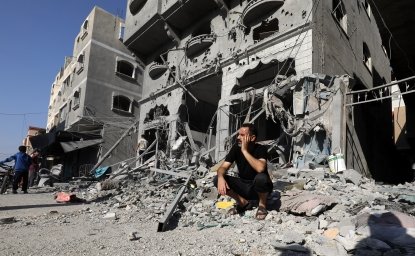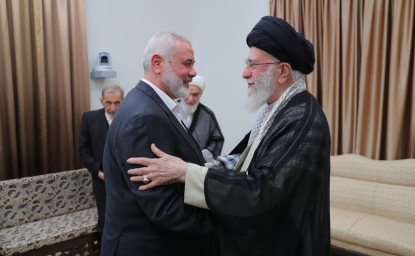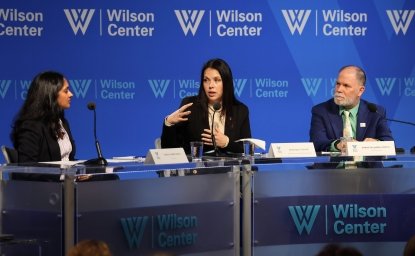By Manal Omar

Libya’s Islamists quickly rose from the ashes after the 2011 uprising that ousted Colonel Moammar Qaddafi. They had been pushed into exile or the underground during his forty-two-year rule. Libyans, who are culturally conservative even if they do not actively practice the faith, esponded enthusiastically to Islamic political parties as they struggled to rebuild a new order.
One year later, the new Islamists were deep into developing progressive theory, but they were still seriously devoid of political experience. They were also plagued by layers of contradictions between their traditional past and the modern political organizations they were trying to create. As a result, Libya’s Islamists faced a sort of existential crisis. Carving out sufficient political space often meant promoting themselves from a nationalist platform or attaching themselves to tribal or regional groups that undercut their own broader Islamic agenda.
The Islamic movement in Libya has been strongly influenced by the Sufi tradition of the Sanussi Order, an unusual and even unlikely blend of Islamic mysticism and strident Salafism. Until 2011, Islamist ideas were shaped primarily in exile. Libyans even attribute the survival of the Islamists to their experiences in the West, where many came into contact with the ideas of the Muslim Brotherhood while students in the United States and Europe. Islamist ideas were banned in Libya, where Qaddafi once compared the movement to a cancer. But they were freely accessed in the West.
Islamist ideas in post-Qaddafi Libya are deeply nuanced. The country’s social conservatism makes any perceived criticism of Islam political suicide. Yet in another seeming contradiction, the same conservatism makes most Libyans reject the notion of Islam as the primary or only platform for a political party. Islamic principles are instead a given. The issue is how Islamic values will shape policy to set the oil-rich North African country back on track. Libyans have also been vocal nationwide about fighting the emergence of Islamic extremism. The framework of Islamic political parties that emerged since the revolution reflects an awareness of all three preferences.
As of 2012, Libya had two large Islamic political parties: The older Libyan Islamic Group is a local branch of the Muslim Brotherhood founded in Egypt. The new Libyan Islamic Movement for Change is a reincarnation of the Libyan Islamic Fighting Group, a jihadist movement that renounced violence in 2006.
The Beginning
Islam has been central to modern Libyan political life for a century. It was introduced by the Sanussi Order, founded in Mecca in 1837 by Mohammed ibn Ali as Sanussi. The Algerian-born cleric sought to regenerate Muslim identity and spirituality. While living in Mecca, he crafted a new order that was austere but rejected fanaticism. The so-called Sanussiyya movement was revivalist, bringing together the Sufi Islamic tradition and religious reforms that looked to the life of the Prophet Mohammed as a social model, which was also the original concept of Saudi Arabia’s Wahhabism. Sanussi moved his new order to Libya in the mid-nineteenth century.
After the Italian occupation of Libya in 1911, the largest anticolonial campaign—a form of jihad—was led by the Sanussi Order. The resistance was symbolized by Omar al Mukhtar, a religious leader and instructor educated by the Sanussi brotherhood. In 1951, when Libya gained independence from Italy, Mohammed Idris, a grandson of Sanussi, was crowned king. His legitimacy as a leader stemmed from the religious order, which he then headed. As King Idris I, he ruled until his ouster in a military coup led by Qaddafi in 1969.
The Sanussi Order thrived in the equally austere Bedouin tribal culture of eastern Libya, or Cyrenaica, which is also where the rebellion against Qaddafi was later launched. Qaddafi clearly viewed the revival of the order as a threat. During Qaddafi’s rule, Mukhtar’s grave was moved from Benghazi to a remote area beyond Tobruk in an attempt to minimize both Mukhtar’s place and Sanussi influence in Libyan history. After Qaddafi was toppled, Mukhtar was revived as the symbol of resistance—eighty years after his death in 1931. Posters, key chains, and graffiti bearing Mukhtar’s image became visible or available for sale across Benghazi.
The Libyan branch of the Muslim Brotherhood emerged in the 1950s, when King Idris offered refuge to Egyptian members fleeing the rule of Gamal Abdel Nasser. Many Egyptians offered political asylum in Libya taught at Libyan universities, where they built a strong student following. Over time, the students created their own branch of the Brotherhood.
Dictatorship and Doctrines
Like leaders of many authoritarian regimes, Qaddafi used religion to try to gain wider legitimacy. He called for imposition of Sharia law and banned alcohol, nightclubs, and prostitution. He also pushed Arab nationalism and socialism as cornerstones of nation building. But Qaddafi was the only secular leader to introduce doctrinal changes and innovations to Islam.
The former military officer often went on national television to challenge traditional religious scholars. In a controversial statement, he once claimed that the Koran was the only source of authority for establishing Islamic law—a contention that marginalized the Hadith (the sayings of the Prophet Mohammed) as well as religious authorities such as the ulema (Islamic scholars) and the fuqaha (jurists). Qaddafi then began making his own interpretations based on his reading of the Koran.
To eliminate potential opposition, Qaddafi disbanded the Muslim Brotherhood when he came to power. In the 1970s, the Brotherhood existed largely in exile. It was not able to reestablish a presence inside Libya until the late 1980s. It operated predominately underground, although it was able to establish its own shura (consultative) council inside the country. Ironically, the Brotherhood was sustained partly by the Qaddafi regime’s policy of sending students on scholarships overseas, where young Libyans were reintroduced to the Brotherhood’s philosophy.
As in other Brotherhood branches elsewhere in the region, Libya’s members came largely from the middle class and professional class. They were not all like minded, however. In an important split, one faction viewed the Brotherhood as a pan-Islamic movement and eagerly sought coordination with Cairo. Other factions argued that the movement should adapt the Brotherhood’s general principles to the specific Libyan national context.
During the 1970s and 1980s, the first jihadist cells were also created in Libya. They gathered around radical sheikhs who advocated armed struggle. In the 1980s, young militants mobilized around the call for jihad in Afghanistan against the Soviet Union. After the Soviet Union’s withdrawal from Afghanistan in 1989, most militants returned to Libya and shifted their focus to the injustices of the Qaddafi regime.
Reconciliation
For most of his four-decade rule, the Qaddafi regime justified cracking down on Islamic political groups in the name of state security and counterterrorism. But in 2006, Saif al Islam, Qaddafi’s son and political adviser, began negotiating reconciliation with the Islamists.
Saif al Islam pushed for rehabilitation of imprisoned Islamists in exchange for recognition of the government, renunciation of violence, and formal revisions of the Islamists’ doctrines. The reforms played out in phases. More than one hundred members of the Muslim Brotherhood were released in 2006, and by 2008, hundreds of members of the Libyan Islamic Fighting Group had also been freed.
Among the key authors of the 2006 reconciliation agreement was Abdelhakim Belhaj (then a member of the Libyan Islamic Fighting Group), who secured his release from prison through the agreement. He represented the evolution of Libya’s jihadis in many ways. He had gone to Afghanistan in 1988, where he fought the Soviets, and remained until 1992. In 2004, he was detained in Malaysia and brought to Thailand, where U.S. Central Intelligence Agency questioned him. He was eventually handed over to Libyan authorities, who placed him in prison.
The reconciliation document he helped craft marked a pivotal turning point in Libya’s Islamist history. It redefined the rules of engagement for jihadists and repudiated the al Qaeda doctrine that justified killing civilians. The deal explicitly stated that Islamic tradition forbids the targeting of women, children, elderly people, religious leaders, traders, and unarmed civilians.
After the Revolution
After Qaddafi’s ouster, Libya’s Islamist politics solidified around two formal organizations—the Libyan Islamic Movement for Change and the Libyan Islamic Group, which is the Brotherhood offshoot—and several smaller “gatherings” around prominent Islamic figures such as Sheikh Ali Sallabi and Sheikh al Sadiq al Gharyani. There are also informal armed Islamic groups, particularly in the eastern provinces such as Derna. But these groups have not been transformed into major political players.
Outside of tribal and regional ties, Libya’s most recognized sociopolitical organization is the Libyan Islamic Group. It claims to have participated in the revolution from the onset by providing food, aiding the wounded, and conducting humanitarian missions. It soon vowed to create a moderate political party. It organized events where women were invited to attend and speak. It sponsored new civil society organizations. Less than a year after Qaddafi’s ouster, the Libyan Islamic Group’s membership had doubled.
The Muslim Brotherhood offshoot enjoyed three advantages. First, it was able to work directly with the people—and gain popularity on the streets—through humanitarian and economic programs. These social contracts gave it a strong advantage over other political parties.
Second, the Libyan Islamic Group was part of an international pan-Islamic movement able to share lessons for grassroots mobilization and political participation. More than other Libyan groups, it demonstrated political maturity by ensuring that its members voted as a bloc, rather than as individuals, in new government organizations. This was particularly true in local councils.
Finally, the Libyan Islamic Group demonstrated transparency. In November 2011, it held a four-day national conference to elect leaders. No other political party had held a national conference, and leadership negotiations had often taken place behind closed doors. During the national conference, the plenary assembly elected Bashir Kabti as the Muslim Brotherhood’s general representative.
Kabti was a somewhat controversial choice. He had strong ties to the old regime and was not connected to the original Libyan branch of the Brotherhood. He lacked charisma. And critics charged that he lacked a longer-term national vision, a drawback that could diminish support. Some felt he had stronger loyalty to the Brotherhood’s pan-Islamic movement than to the focused mission of transforming Libya.
Although its membership has steadily grown, the Libyan Islamic Group may still not be able to win elections on its own, a weakness that has characterized trends in other Arab countries since 2011. It has done well at the social grassroots level—specifically among the lower socioeconomic classes—in terms of mobilization, education, community programs, and youth programs. But some Libyans remain suspicious of the movement’s long-term goals, so the Brotherhood offshoot may also need to enter into broad coalitions and alliances to rule the country.
The second largest Islamist party is the Libyan Islamic Movement for Change, the reincarnation of the militant Libyan Islamic Fighting Group. The party was cofounded by Belhaj, the head of the Tripoli Military Council, in August 2011.
Belhaj has also been a leader in holding the National Transitional Council accountable, a position that has earned him popularity. His main grievance is that the council’s agenda is too secular and too focused on the West’s goals for Libya—issues that have generally caused significant tension between Islamists and the Western-oriented members of the transition government.
Belhaj and Sallabi have both warned of “extremist secularism”—a message that strongly resonates in Libya. In September 2011, Belhaj explained this view in an op-ed piece in The Guardian:
What worries us is the attempt of some secular elements to isolate and exclude others. Libya’s Islamists have announced their commitment to democracy; despite this, some reject their participation and call for them to be marginalised. It is as though they want to push Islamists towards a non-democratic option by alienating and marginalising them.
Belhaj is well respected for his years in Abu Slim prison, but many Libyans were surprised by his appointment to head the Tripoli Military Council shortly after Qaddafi’s ouster. Rebels reported that Belhaj was not present during the fall of Qaddafi’s compound and arrived only shortly afterward, in time to deliver the victory speech. Belhaj has also faced accusations that Qatari funding was funneled directly to him, triggering concern within the transition government that his party has an unfair advantage over other parties.
The political direction of the “gatherings”—whether they will join one of the two formal parties or emerge as independent political entities—was still uncertain in early 2012. The individual clerics had not expressed loyalty to any party. In Tripoli, Sheikh Gharyani was widely credited with taking the revolution from its roots in the east to the capital of Tripoli in the west with his address to the nation in August 2011.
Under Qaddafi, Gharyani had been a former head of the Supreme Council for Fatwas and a faculty member at Al Fateh University’s Department of Islamic Studies. But his political independence was firmly accepted in Libyan society. Sheikh Sallabi, widely viewed as the most influential Islamist leader in Libya, spent many years in prison under Qaddafi. Sallabi is often linked with the Muslim Brotherhood.
Key Positions
There is no monolithic voice that speaks for the Islamists in Libya. The two main political parties have not issued detailed platforms; their positions are discerned largely from the speeches or behavior of their individual leaders. The two groups vary on some issues; they also have internal divisions. Both are, in effect, still learning.
Democracy
Both parties have taken initial steps that reflect interest in nonviolent participatory political action. The Libyan Islamic Group is the only group in Libya to hold a national conference open to all Libyans where the representation was elected.
The Libyan Islamic Movement for Change—which grew out of local jihad cells in the late 1970s and 1980s—has responded to public demands to avoid extremism. Its members agreed in March 2011 to come under full command of the National Transitional Council, thus indicating a willingness to work under a central authority and with other parties—abandoning the guerrilla tactics that had been the trademark of the Libyan Islamic Movement for Change’s predecessor, the Libyan Islamic Fighting Group, in the 1990s.
Islam
The core dispute is not over whether Islam will play a role in the new Libya but over what specific role it will play. The greatest concern is coming from within the Islamist movement. Some members are concerned about a new brand of Islam intolerant to other interpretations, such as the rich historical Sufi tradition. Some Islamists even fear a new breed of extremism. Other Libyans fear a clash of Islamic ideologies. Islamists often tend to lose their Islamic identity once they reach power and turn into political entities.
Therefore, many Libyans express a fear of political Islam while simultaneously calling for a central role for the faith within the new state. What may seem to be a contradiction is extremely clear in the Libyan mindset.
Secularism
Libyans are overwhelmingly conservative and call for Islam to have a large role in the nation-building process, but the sparsely populated North African country also has a strong secularist movement. For four decades, Qaddafi fostered a fear of Islamists. In a 1989 speech, for example, he said that Islamists were “more dangerous than AIDS.”
Women
Libyan women have generally not fared well under either secularists or Islamists. In January 2012, the National Transitional Council dropped a proposal to create a 10 percent minimum quota for women in parliament. Some Libyan women fear that Islamist parties will further marginalize women—a fear based on what has happened to their counterparts in Iraq, where a drastic decline in elected women is widely attributed to the rise of religious political parties. But female activists scoff at the prospect of living in a Taliban-like nation, even as many reject the Western idea of women’s liberation.
Minorities
In terms of minorities, many Islamists point out that historically the oppression of minorities in Libya has been the result of a clash between the Arab cultures and was not tied to Islamic principles. For example, the Berbers do not have any problem with Islam and are more likely to clash with the notion of Libya as an Arab state than with the notion of Libya as an Islamic state. The focus among the minorities within Libya is on fighting for their cultural rights, and Islamists argue that this objective does not contradict any Islamic principles. Minorities would be able to speak their local language, have their own schools, and name their children as they chose.
The United States and the West
All political parties have expressed gratitude to the United States and to the North Atlantic Treaty Organization forces for support in overthrowing Qaddafi. There is generally a keen interest in maintaining positive relationships with Western nations while also trying to secure sovereignty during the transition process. Many of the Brotherhood members were educated in the West, which may foster a basis for international contacts.
Israel
Like many Arab autocrats, Qaddafi used the Palestinian cause to focus on an external enemy and promote himself as a regional hero. He even instituted a special mandatory tax to support jihad in Palestine. But since his ouster, there has been an unspoken consensus across politics that the Arab-Israeli conflict is simply not a priority for Libya during the transition. Israel is also not a neighbor, so the conflict is literally not an urgent frontline issue.
Overall, all Libyan parties are still committed to supporting the Palestinian right of self-determination. But the Libyan trend is to remain in the background and delegate responsibility to the Palestinians themselves.
The Future
For the foreseeable future, the status of Islam as a religion and of Islamists as political forces will play a dynamic role in the nation-building process in Libya. The centrality of Islam has been officially recognized by the National Transitional Council’s leader. Council chairman Mustafa Abdul Jalil gave two public addresses highlighting the importance of Islam. The first was after the fall of Tripoli in September 2011, and the second was in October 2011, when he announced the liberation of the country.
Yet Libyans across generations and religious affiliations emphasize the central purpose of the revolution as freedom, justice, and opportunities. Many say they are ready to protect these principles with their lives and see the framework—secular or Islamic—as secondary. Libyans also appear widely intent on eradicating all forms of extremism.
Libya has several advantages over other Arab countries in transition. First, more than 90 percent of Libyans are Sunni Muslims who follow the Maliki school of thought. Maliki is the more moderate of the four traditional schools of jurisprudence. Libya’s Islamic movements are also partly rooted in a Sufi tradition, notably the Sanussi Order. The country also has vast oil wealth but a small population of some 6.5 million, factors that could help prevent the kinds of economic tensions that are troubling other Arab countries.
Manal Omar was the director of the North Africa, Iraq, and Iran programs for the United States Institute of Peace when this chapter was published in 2012. She was a member of the Libya Stabilization Team under the National Transitional Council formed during the revolution. She was previously a regional program manager for Oxfam GB and led humanitarian responses for Yemen, Lebanon, the Palestinian Territories, and Iraq. Omar is the author of Barefoot in Baghdad (2010).

The Islamists
Learn more about Hamas and how it relates to similarly aligned organizations throughout the region. Read more

Explore More
Browse Insights & Analysis
Israel Escalates Attacks in Gaza: What’s Next?

Israel Expands Operations on Multiple Fronts: Perspectives on the Conflict

